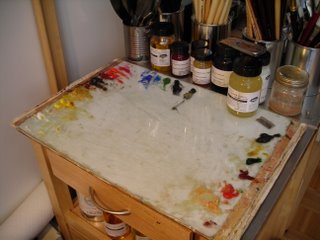Painting Process 2

My Palette
There are so many colors available now to the modern painter that it becomes very hard to choose a palette that works. In the old days painters had a very small choice of colors and they were able to achieve greatness with this restricted palette. I was lucky enough to take a foundations class on color where I was taught about mixing and choosing colors. I adopted the palette suggested to us in class and it has worked wonders. The main idea of this palette is to use two shades for each of the primaries, one cool one warm, to get the right mixtures. Here's what I use as a palette:
Titanium White (the brightest white, cool white)
Zinc White (warm white)
Flake White (ideal warm white for flesh tints)
Unbleached Titanium Pale (very light natural Titanium I use for backgrounds)
Cadmium Yellow Lemon (cool yellow for mixing greens)
Cadmium Yellow Medium
Cadmium Yellow Deep (warm yellow for mixing orange)
Naples Yellow (my favorite color, I use it almost in everything, including flesh tints and for
onions. I use genuine Naples Yellow, which is a lead based pigment. Both Naples
Yellow Light and Deep are much richer than the synthetic ones)
Yellow Ochre
Raw Sienna (I use it sparingly)
Burnt Sienna (a must in my palette)
Burnt Umber
Raw Umber (deep rich brown. I use this instead of black)
Iron Oxide Red Med./Mars Red/Indian Red (good for those rich reds if mixed with Cad. Red.)
Cadmium Red Medium(warm red for mixing orange)
Cadmium Red Light (love to use it for the bright areas of a tomato)
Quinacridone Red/Permanent Rose (cool red for mixing the ideal purple with ultramarine blue.
I have stopped using alizarin Crimson since it fades, more
so than it's natural counterpart Madder Lake.)
Ultramarine Blue (cool blue for mixing purple)
Phthalo Blue (warm blue for mixing greens, I rarely use this color)
Cobalt Blue (I love cobalt blue)
Genuine Cerulean Blue (I love this color and try to use it as much as I can.)
Chrome Oxide Green (I use it sparingly)
This is my main palette, I sometimes use other colors depending on the effect I'm trying to achieve.



Comments
Luis
Luis